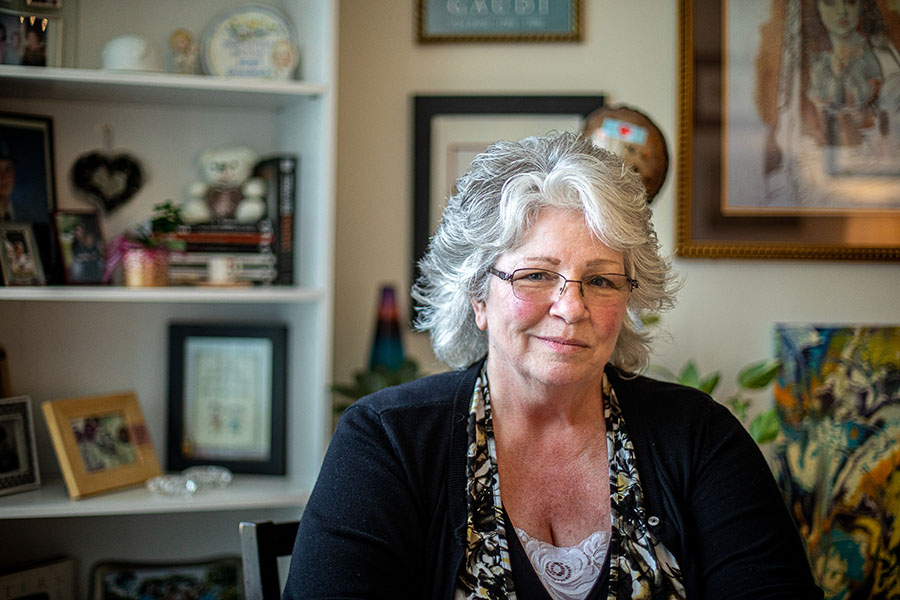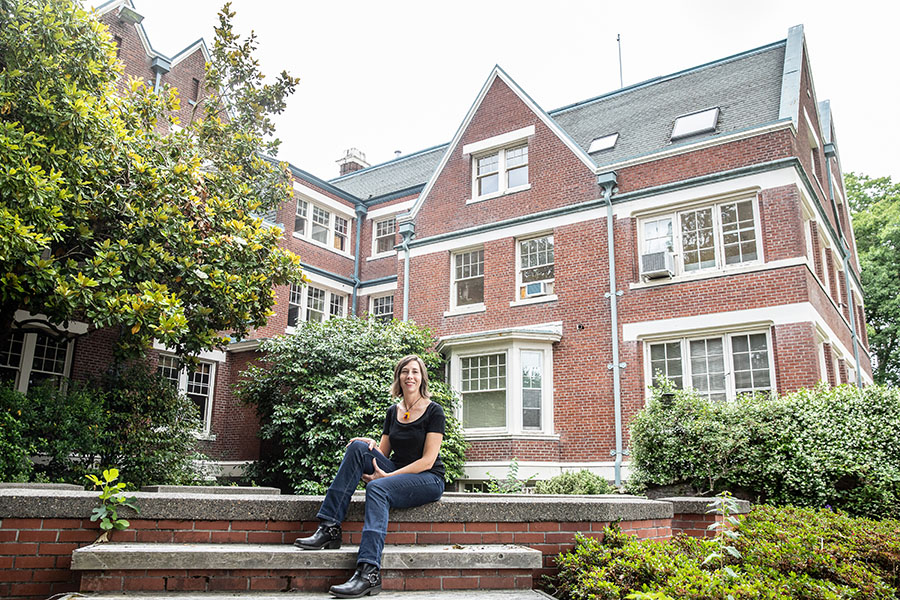Governments and voters agree stable housing sits at the heart of health, and the affordable-housing sector finds itself flush with funds. Yet competition, complexities and growing need make housing everyone a challenge.
Kim Rojas was in a bind.
Her husband, an IT consultant, died unexpectedly three years ago. Her devastating loss was compounded by her sudden financial insecurity. “He had a good income,” recalls the 61-year-old, who picked up various jobs — part-time teacher, Uber driver and the like — during her marriage.
Rojas, who works part-time as a bilingual administrator for the City of Hillsboro’s parks department, rented a single room in a local farmhouse. The living situation was not ideal for the self-described introvert. “I am not antisocial, but I kind of am,” she says with a knowing laugh. Yet even the smallest one-bedroom apartment was out of financial reach. “They start at $1,500 to $1,600 a month, and the complex can raise the rent anytime they like.”
 Kim Rojas in her Cornelius Place apartment. Credit: Jason E. Kaplan
Kim Rojas in her Cornelius Place apartment. Credit: Jason E. Kaplan
In November 2019, Rojas was accepted into Cornelius Place, a two-story apartment complex for low-income seniors, which sits atop a new public library. The move changed her outlook. “I wanted a better quality of life, and this place lets me have that,” she says. Rojas reports that even though she “lives gloriously alone,” she now prioritizes socializing with her community in ways that surprise her. She signs up for activities, hangs out in the newly reopened community room to watch Sunday sports and volunteers at the library.
“At my age and with the money I make, I could not have this life outside of Cornelius Place,” she says. “Housing is now one less thing to worry about.”
Rojas’ story proves that housing is health care, plain and simple. “It is not rocket science,” says Rachel Duke, executive director of Community Partners for Affordable Housing. “We know what works.”
It certainly feels intuitive. Having stable, affordable housing relieves an enormous burden. Knowing where you are going to sleep tonight, and that you can afford to keep sleeping there every night thereafter, lifts a cloud of hopelessness and despair. It also means you can manage medications, make better choices for yourself and your family, and belong to a healthy, thriving and safe community. Add wraparound supports like translation services, social programming, food pantries and summer lunch programs, and the success rate climbs even higher.
At this moment, the concept that housing equals health care feels universally accepted. Voters, appalled by rising homeless rates, approved measures to fund a pipeline of affordable-housing projects. Every layer of government seems laser-focused on the issue. In June the Oregon Legislature approved Senate Bill 8, which allows affordable housing to be sited on land zoned for commercial use as well as land owned by public or religious entities. It also allows affordable housing to be developed at greater densities on land already zoned for residential use.
“Oregon is in a renaissance of affordable housing right now,” says Kurt Creager, executive vice president of BRIDGE Housing, a nonprofit that develops and manages affordable housing on the West Coast. “There are good local resources, helpful federal policies and the political will to see it built.”
Yet plenty of barriers remain. Money may be flowing, but competition among nonprofits for those funds is fierce. Volatile lumber prices, high land costs and weird COVID-19-induced shortages have unexpectedly boosted construction expenses. Meanwhile, rental shortages continue while the number of cost-burdened Oregonians continues to grow.
“Affordable-housing development often feels like Indiana Jones and the Temple of Doom,” says Creager with a laugh. “Just when you’ve dodged the crushing ceiling, you fall into a pit of snakes. That is our life. That is what we do.”
More than intuitive, robust, quantifiable data prove that affordable housing is critical to good health outcomes. The Providence Center for Outcomes Research & Education’s 2016 study found that after people moved into affordable housing, total Medicaid expenditure declined by 12%, outpatient primary-care use increased 20% and expensive emergency-department visits fell 18%.
The same can be said for efforts to house the chronically or recently homeless. A recent Multnomah County study — which layered efforts between the Corporation for Supportive Housing, Health Share of Oregon, the Joint Office of Homeless Services and the local Public Safety Coordinating Council — found that supportive housing resulted in more than 5,000 avoided emergency-department visits, 400 fewer jail bookings and 50 fewer inpatient psychiatric stays for chronically homeless individuals.
The momentum seems to be growing. The Portland region continues to deliver properties at an impressive click. Metro reports that it is ahead of production goals for new affordable housing across the tricounty area. Tapping into the $653 million bond approved by voters in 2018, Metro, along with seven county and city partners, is expected to deliver 20 housing developments holding 2,000 new affordable rental homes by the end of 2023. Four shovel-ready properties are slated to open this year. All these projects will house up to 6,000 people in need.
And more is to come. The bond calls for a total of 3,900 affordable homes, which promise to house 12,000 people. These will also include 1,600 “deeply affordable” homes for those making 30% of area median income or about $26,000 or less for a family of four.
The effort is about more than just building homes. For housing to really impact health, other factors must be considered. “Developers agree that increasing stock is key, but we have to remember that people with different backgrounds and experiences will live in these buildings,” says Susan Neufeld, vice president of evaluation and residential program design at BRIDGE Housing.
In an effort to create cohesive communities, Neufeld and her team deeply research the surrounding neighborhood, searching for amenities already in place and identifying any gaps. They then work to fill those gaps with the new structure. These community assets look different with every project, but they may include amenities like affordable food venues, other appropriate retail or needed community space. For instance, Cornelius Place, the BRIDGE Housing project where Rojas lives, is a mixed-use project. It sits atop a public library and shares space with the local YMCA.
“Part of our goal is to ensure to the best of our abilities that the asset is in service to the community,” Neufeld says. “It is about leveraging the physical space not just for the residents but for the whole neighborhood.”
Along these lines, Neufeld and her team are focusing on child care. They have a strategic plan to embed as many subsidized day cares and preschools in their properties as possible. “The pandemic revealed that child care is vital to creating stable, well-cared-for families,” she says. “Without child care, businesses suffer. You cannot recruit and retain a young workforce without it.”
Siting these properties presents another concern. Metro is pursuing a mixed approach with 73% of its projects located in areas with higher-than-average proportions of people of color, people with limited English proficiency or both. This, according to Metro, gives people with low incomes greater opportunities to remain in their neighborhoods, stay connected to their network of friends and family, and continue to access cultural amenities.
“We know all of the ingredients of a healthy community. Crime is low and there is a high level of social cohesion,” says Neufeld.
Metro is also bringing affordable housing to areas that have not been accessible due to exclusionary zoning, high housing prices or destructive gentrification. It is also investing in affordable housing in areas that have no affordable-housing options.
This could create the classic conflict of established neighborhoods bristling against the proposed construction because they fear more density, more cars and more conflict. “‘Not in My Backyard’ is real,” says Duke. Her organization tries to counter the effect by working with the surrounding community and striving to build positive relationships, she says.
Sarah Stevenson, executive director of Innovative Housing, observes a sea change in communities. Her organization has been invited by neighborhood associations seeking more affordable housing. “They see the need,” she says, directly referencing the Laurelhurst Neighborhood Association’s support for Innovative Housing’s affordable development in the area. “We might have anticipated a fight with them 20 years ago, but in 2020 they submitted letters of support for the project.”
With abundant funding and more welcoming neighbors, it would seem that affordable-housing efforts have a glide path ahead. But there are still plenty of hurdles to delivering affordable communities that support health.
Take that abundant funding, for instance. At the federal level, a permanent fixed 4% floor for the low-income housing tax credit was welcome news. But soaring building- material costs now make those savings moot.
During the pandemic, lumber prices spiraled upward, setting new records almost daily until an apparent peak May 20, according to Random Lengths, a wood-products industry tracking firm. As this issue went to press, prices had begun to fall, but at the end of April they were up 340% from the same time in 2020. And lumber does not just go into framing a house. Those added costs hit cabinets, doors, windows and flooring. The price of other building materials like drywall, steel and copper is also surging, while COVID-induced supply-chain disruptions make securing things like elevator parts harder too.
“In most of our markets, including Oregon, the benefits we would have achieved from fixing the 4% is being used to mitigate construction price increases,” says Creager. Still, he remains sanguine. “We would have had to deal with those price increases anyway.”
 Sarah Stevenson, executive director of Innovative Housing, at the Anna Mann House in Portland’s Laurelhurst neighborhood. Credit: Jason E. Kaplan
Sarah Stevenson, executive director of Innovative Housing, at the Anna Mann House in Portland’s Laurelhurst neighborhood. Credit: Jason E. Kaplan
What is more frustrating to nonprofit developers is having a pipeline of potential projects that keep missing out on funding year after year. “I think our system for assembling capital financing is extremely inefficient,” says Stevenson. “There are direct costs and a lot of indirect costs in the way we are doing this.” She reports seeking land and projects that the City of Portland might want to fund, but “we do not know what their priorities are until they announce the funding. This really puts us on our back foot.”
Instead of this annual, cyclical competitive approach, Stevenson and others hope for a more coordinated method that prioritizes projects already in the queue. “The sites are controlled, the projects are designed and the contractor is onboard,” she says. “There is more resource and we are lucky to have it. But it could be going out the door more efficiently.”
The development game gets even harder outside of the Portland metro area. Smaller rural localities do not have the same financial resources, such as tax increment financing. “It is challenging because the state, in these competitive funding cycles, gives points for local contributions for housing,” explains Stevenson. “If the jurisdiction is small and without dedicated resources, it is hard for them to make financial matches and be competitive.”
Ironically, the low rents found outside of the Portland metro area make it even harder to secure conventional mortgage funding. “We like lower rents, but if they are too low, it means the property cannot support much of a mortgage, which means we need more capital sources to develop it,” says Stevenson.
Back in 2016, Portland made national news when six health providers — Adventist Health Portland, CareOregon, Kaiser Permanente Northwest, Legacy Health, Oregon Health & Science University and Providence Health & Services-Oregon, along with Central City Concern — came together to tackle homelessness. Realizing that there is no health without safe, stable housing, the group committed a combined $21.5 million to build nearly 400 housing units. The Housing Is Health initiative was born.
The work has continued, and accelerated, since then. But will it be enough?
The entire U.S. is facing a housing shortage, with mortgage-finance company Freddie Mac identifying the need at 3.8 million single-family homes nationwide. The problem is particularly acute on the West Coast and in Oregon. The Oregon Center for Public Policy estimates that one in three households across the state are cost-burdened, spending more than 30% of their income on housing. Housing Oregon figures that there are nearly a quarter of a million families who make less than $33,000 and need affordable housing, yet there are only 143,000 units available.
Displacement by last year’s wildfires compounds the issue. And the June 30, 2021, expiration of Oregon’s eviction moratorium has everyone concerned about what comes next.
“Given where we work, unit development feels like digging sand on a beach,” says Neufeld. “We are not keeping up with demand, and I’m worried about how the pandemic is impacting the people we serve.”
Still, the good news is really good. The pipeline of affordable-housing projects remains robust. Yes, nonprofit developers must continue jumping through hoops to true up multiple funding sources, but there is a chance that a large pot of federal money from President Joe Biden’s Build Back Better infrastructure plan may come with a more simplified direct funding stream.
And for people who get to move into affordable housing, the improvement in their health, their quality of life and their community is palpable. Rojas, the senior who lives at Cornelius Place, certainly agrees. “I love this place,” she says. “Some people think it is small, but I had a colleague over and I opened the door and said: ‘Welcome to my palace.’”
To subscribe to Oregon Business, click here.








